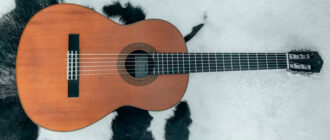Guitar strings are an essential part of playing the guitar. The way you press the strings can greatly affect your playing style, sound quality, and overall performance. The objective of this article is to provide a detailed guide on how you can make guitar strings easier to press.

Whether you are a beginner or an experienced player, this guide will help you to press the strings more efficiently, reducing the chances of sore fingers, fret buzz, or other common playing difficulties.
Why guitar strings become hard to press down
Guitar strings can be a challenge to press for various reasons. Here are some of the key factors that contribute to making it difficult to press guitar strings:
High action: The action of a guitar refers to the distance between the strings and the fretboard. If the strings are close to the fretboard, the guitar has low action, while if they are further away, it has high action.
Having high action on a guitar means that more pressure needs to be applied to the strings to touch the frets. It’s important to note that high action does not necessarily equate to poor quality or difficulty in playing.
In fact, having either too low or too high action can pose challenges in playing the guitar. For beginners, starting with low action is recommended as it requires less effort and enables quicker playing.
However, if the action is too low, the strings can become difficult to bend and create fret buzz.
On the other hand, high action allows for the harder striking of the strings and a fuller sound, but also requires more pressure to press the strings harder and increased string bending.
String material: When it comes to acoustic guitars, nylon strings tend to be easier to press compared to steel strings on electric guitars. Lighter strings are also generally easier to press than heavier strings.
Bad saddle and bridge positioning: The high action makes strings harder to press, often due to the nut, truss rod, saddle, or bridge. The bridge is at the lower body of the guitar and the saddle, usually plastic or bone, is attached to it and lifts strings to the desired height while keeping them off the fretboard.
The saddle and bridge also transmit string vibrations to the soundboard. If the neck is not causing high action, check the saddle height. If too tall, shaving or replacing the bridge may help.
Just like the nut, the bridge, and the saddle lift the strings to the desired height, and it keeps them in place without letting the strings rest on the fretboard.
Guitar model: Different guitar models have their own unique neck widths and string action, both of which can impact the ease of pressing the strings.
Playing a cheap guitar may prove difficult as the strings often have high action, which is the result of poor manufacturing processes such as an improperly cut nut, unadjusted neck, and bridge. A detailed guitar requires more time and expertise to produce, and a well-made instrument will have a lower action and be easier to play.
Finger strength: The strength of your fingers also plays a significant role in how easily you can press the strings. If you are a beginner, it may take some time for your fingers to build up the necessary strength.
Choosing the wrong strings: If you choose strings that are not suited to your playing style, you may find it harder to press them. For instance, if you play a lot of heavy strumming, you may want to consider using heavier strings to make it easier to press them.
Too much pressure: Applying excessive pressure while attempting to press the strings can make it more difficult to do so.
Improper string rest: Strings that are not properly resting on the fretboard can also contribute to making it harder to press them.
String vibration: The vibration of the string also plays a role in determining how difficult it is to press the strings. If the strings are vibrating excessively, it can make it more challenging to press them.
Proper fretting: Proper fretting is critical in making the strings easier to press. If you’re not fretting the strings correctly, it may be necessary to adjust your playing technique to make it easier.
To summarize, the ease of pressing guitar strings is influenced by a combination of factors, including string material, guitar model, finger strength, the choice of strings, pressure applied, string rest, string vibration, and proper fretting technique.
Methods to make guitar strings easier to press
Guitar strings, whether electric or acoustic, play an important role in the sound and feel of the instrument. When playing the guitar, it is essential that the strings are easy to press down, as this makes playing more enjoyable and helps to avoid discomfort and injury.
Unfortunately, some guitarists experience difficulty in pressing down their strings, leading to frustration and a decrease in the quality of their playing.
In this part of the article, we will explore the reasons why guitar strings can become hard to press down and what can be done to solve this problem.
String gauge and types of strings
The thickness of the guitar strings, or the string gauge, is a major factor in how easy or hard they are to press down. Heavier strings, or those with a larger gauge, are generally more difficult to press than lighter strings.

However, light strings can also cause problems for some guitarists, particularly those with weak fingers or who play a lot of contemporary jazz or classical guitar styles that require fast, intricate finger movements.
In terms of string type, steel strings are generally easier to press down than nylon strings, which are typically used on classical guitars. Electric guitar strings are also different from acoustic guitar strings and can affect the ease of pressing down the strings.
It is important to choose the right strings for your guitar and playing style to ensure that they are easier to press.
Guitar neck and nut slots
The guitar neck and nut slots also play a role in how easy or hard it is to press down the strings. If the nut slots are too high, it can cause the strings to be too far from the fretboard, making it more difficult to press down the strings.
Similarly, if the guitar neck is not straight, this can also affect the ease of pressing down the strings.
It is essential to have your guitar set up by a professional to ensure that the neck and nut slots are in good condition and properly adjusted.
Amount of pressure
Another factor to consider is how much pressure is being exerted on the strings. If you are pressing the strings too hard, this can make them harder to press down.
It is important to use the right amount of pressure when pressing the strings and to pay attention to your playing technique to ensure that you are not using too much force.
Shorter scale length and lighter strings
Shorter scale length guitars, such as electric guitars, typically have light strings and are easier to press down than guitars with a longer scale length, such as classical guitars.

Additionally, electric guitars often have a flatter fretboard, which can also make it easier to press down the strings.
If you are having difficulty pressing down the strings on your classical guitar, you may want to consider switching to a light gauge or to an electric guitar with a shorter scale length.
Good quality strings
Finally, it is important to use good-quality strings that are designed to exert the right amount of pressure and have the right gauge for your guitar and style of play. Using strings that are too old or have lost their tension can also make them harder to press down.
If you are experiencing difficulty pressing down your strings, it is significant to replace them with fresh, high-quality strings.
Light gauge strings
One of the most effective ways to make guitar strings easier to press is to switch to lighter gauge strings. The gauge of a string refers to its thickness and directly affects the tension exerted on the strings.
Thinner strings have less tension, making it easier to press them down onto the fretboard. This is particularly useful for electric guitars, which typically use lighter gauge strings, or for acoustic guitars with steel strings.
String gauge
The string gauge you choose will depend on the type of guitar you are playing and your personal style of play.
Classical guitar players, for example, typically use lighter or medium strings, while metal guitarists often prefer heavier gauge strings.
If you have weak fingers, it may be more beneficial to switch to lighter gauge strings, but if you have good finger strength, you may prefer the sound and feel of medium or heavy strings.
Guitar setup
A proper guitar set up is also essential for making strings easier to press.

This includes adjusting the truss rod, which helps to control the tension of the strings, and ensuring that the nut slots are properly cut.
If the nut slots are too deep, it can be difficult to press the strings down, but if they are too shallow, the strings can buzz. A guitar technician can help you to set up your guitar for optimal playing comfort.
Playing technique
In addition to choosing the right strings and having a properly set up guitar, your playing technique can also have a big impact on how easily you can press the strings.
It is important to use more than one finger when fretting notes and to use a gentle playing style to prevent sore fingers.
Beginner guitarists may also benefit from taking lessons from a guitar teacher to learn proper playing techniques and prevent developing bad habits.
Truss rod adjustment
The truss rod adjustment can also affect the ease with which you can press the strings. If the truss rod is too tight, the strings will be harder to press, but if it is too loose, the strings can buzz.
It is important to have the truss rod properly adjusted to provide the right amount of tension for your style of play and desired sound.
String tension
The tension of the strings also plays a role in how easily you can press them.
Thinner strings have less tension, making them easier to press, while thicker strings have more tension and can be harder to press.
It is significant to choose the right strings for your style of play and to ensure that they are properly set up for optimal tension of the strings.
Fretting hand
Finally, it is essential to develop good finger dexterity and strength in your fretting hand. This can be done by practicing regularly and by using proper fretting techniques to prevent sore fingers.
A lighter gauge string can also help to develop finger strength, as they require less pressure to press down onto the fretboard.
Train the strength of your fingers
Guitar playing should be a smooth, effortless, and instinctive experience, but this can be a challenge for beginners. At first, strings will feel tight, and you may be tempted to press harder, but a gentle touch is all you need.

To achieve a light touch, practice is key. As you work on strengthening your fingers, you’ll find that you don’t need to apply as much pressure and can play faster. As a beginner, you may tend to use only one finger to pluck the strings, but using multiple fingers and utilizing wrist muscles will reduce the need for extra pressure.
Strings require a specific amount of pressure to create the desired sound, and with practice, your fingers will develop calluses and become stronger and more flexible, reducing the pressure required.
Remember to take breaks and rest your fingers, it’s great to be enthusiastic, and practicing daily for 30 minutes to an hour can speed up the formation of calluses, but avoid overdoing it and playing with injured fingers.
Are there some types of strings that are easier to press
There are some types of guitar strings that are easier to press than others since different strings have different hardness.
Nylon strings on an acoustic guitar tend to be easier to press than heavier electric guitar strings. Light strings, such as those with a thin gauge, are generally easier to press than heavy strings.
Different types of strings can also impact how hard or easy it is to press the strings. Lower gauge strings, for example, are often easier to press.
However, it’s important to keep in mind that easier-to-press strings may be harder to play, while strings that are harder to press may offer a better sound and playing experience.
Ultimately, the ability to press the strings effectively is a combination of the types of strings, the guitar playing technique, and personal preference.
How the guitar type affects the hardness of strings
The hardness of strings can vary on different types of guitar.
Acoustic guitar typically has thicker strings compared to electric guitars, and thus require more pressure to press down on the guitar’s neck. This means that heavy strings on an acoustic guitar may be harder to press down compared to thin strings on an electric guitar.
However, the hardness of the strings can also depend on the player’s personal preference and style of play.
Some players may prefer strings that are easier to press, while others may prefer strings that are harder to press and exert more tension on the guitar’s neck.
Ultimately, the hardness of strings is a matter of personal preference and can vary between different types of guitar.
Conclusion
In conclusion, making guitar strings easier to press involves a combination of factors such as using lighter gauge strings, having a properly set-up guitar neck, using the right playing style, ensuring shallow nut slots, improving finger dexterity, and choosing the appropriate strings.
It is important to consider these factors and make adjustments as necessary to prevent fret buzz, finger soreness, and other playing difficulties. Guitar players can also consult a guitar teacher or technician for a proper guitar setup and personalized recommendations.
Frequently asked questions
- How do you get used to pressing guitar strings?To get used to pressing guitar strings, start by practicing basic chord progressions and exercises that require pressing the strings down firmly, yet not too hard. Increase the difficulty gradually over time. Also, pay attention to hand and finger positioning to ensure that you are pressing the strings correctly.
- How do I make my guitar strings less stiff?To make your guitar strings less stiff, consider changing the gauge (thickness) of the strings to a lighter gauge. You can also try loosening the tension on the guitar by adjusting the truss rod or tuning down the guitar.
- How do I make my guitar strings bend easier?To make your guitar strings bend easier, using light gauge strings can help. Also, make sure you are using the correct finger placement and technique when bending the strings. Additionally, warm up your hands before playing and use lubricants such as finger oil or lemon oil to reduce friction and make bending the strings easier.






